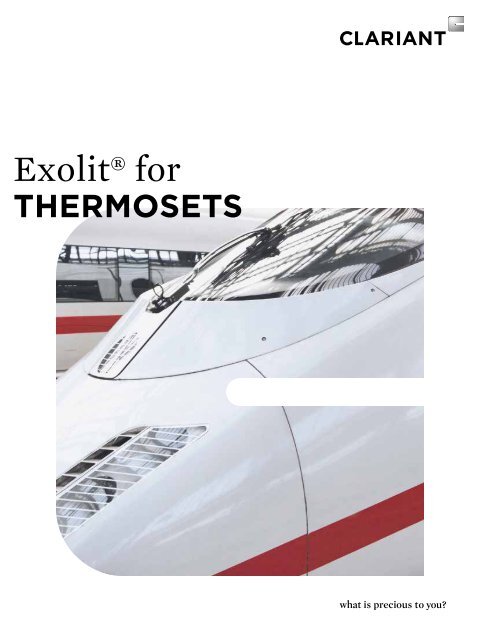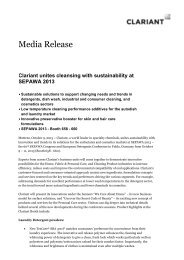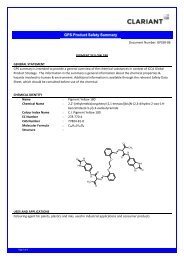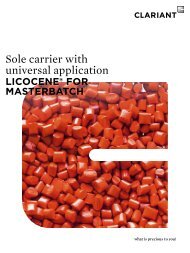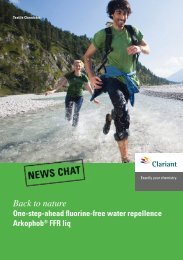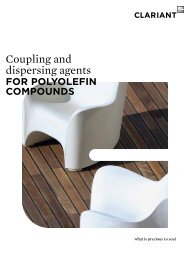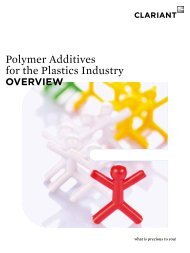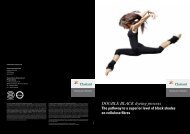Exolit® for
ExOLIT FOR THERMOSETS - Clariant
ExOLIT FOR THERMOSETS - Clariant
- No tags were found...
You also want an ePaper? Increase the reach of your titles
YUMPU automatically turns print PDFs into web optimized ePapers that Google loves.
<strong>Exolit®</strong> <strong>for</strong><br />
Thermosets
Exolit <strong>for</strong><br />
Thermosets<br />
Contents<br />
Exolit <strong>for</strong> thermoset resins 4<br />
Unsaturated polyester resins (UP resins) 6<br />
Epoxy resins (EP resins) 11<br />
Polyurethane and phenolic resins 14<br />
2<br />
Exolit <strong>for</strong> Thermosets
3<br />
Clariant offers a range of<br />
non-halogenated flame<br />
retardants <strong>for</strong> thermosets<br />
under the trade name Exolit.
Exolit <strong>for</strong><br />
thermoset resins<br />
Clariant offers a range of non-halogenated flame retardants<br />
<strong>for</strong> thermosets under the trade name Exolit with the following<br />
characteristics:<br />
In case of fire<br />
· Low smoke gas corrosivity resulting in less damage to<br />
installations and buildings<br />
· Low smoke density, meaning better visibility <strong>for</strong> an<br />
extended escape time<br />
In the final product<br />
· High effectiveness of flame retardants resulting in a<br />
low impact on mechanical properties<br />
· Excellent UV stability and suitability <strong>for</strong> outdoor applications<br />
· Good electrical properties <strong>for</strong> applications in the<br />
Electric and Electronics (E & E) industry<br />
· Good recyclability and low impact on carbon footprint<br />
· Attractive price / per<strong>for</strong>mance ratio resulting in a<br />
competitive system<br />
Under the brand name Exolit, Clariant supplies non-halogenated<br />
flame retardants with a good environmental and health profile <strong>for</strong><br />
thermoset resin systems.<br />
Their advantage lies in their effectiveness, which enables very<br />
low concentrations to be used, while at the same time meeting the<br />
most stringent flammability requirements. As a result, favorable<br />
processing properties are imparted accompanied by low specific<br />
weight and excellent mechanical values of the finished articles.<br />
If Exolit containing systems do catch fire, less smoke will be<br />
released. Since these flame retardants are non-halogenated, no<br />
corrosive fumes such as hydrochloric acid (HCl) or hydrobromic<br />
acid (HBr) are given off. These properties are of great importance<br />
in modern vehicle manufacture and are also important <strong>for</strong> the<br />
new European regulation <strong>for</strong> railway rolling stock EN 45545-2.<br />
Table 1: Different flame test requirements and regulations in certain application areas<br />
Application Area Pictogram Test Country Description Classifications<br />
Construction and building DIN 4102 part 1 Germany Chimney test and small burner test B1; B2<br />
NF P 92-501 France Epiradiateur M1 > M2 > M3<br />
BS 476 UK Surface spread of flame 1 > 2 > 3<br />
ASTM E 84 USA Steiner tunnel Flame spread & smoke density<br />
Transportation – Railway DIN 5510 Germany Fire behaviour and side effects S, SR, ST<br />
DIN EN 45545 EU Smoke density HL3 > HL2 > HL1<br />
Smoke toxicity<br />
HL3 > HL2 > HL1<br />
Spread of flame<br />
HL3 > HL2 > HL1<br />
Cone calorimeter test<br />
HL3 > HL2 > HL1<br />
NF P 92-501 France Epiradiateur M.1, M.2, M.3<br />
ASTM E 162 USA Surface flammability A > B > C<br />
ASTM E 662 USA Smoke box Smoke density (Ds) value<br />
Transportation – Aviation FAR 25.853 USA Smoke density yes/no<br />
ABD 0031 Airbus Smoke density & toxicity CO; HCN; NO x ; HCl; HF; SO 2<br />
Electrical engineering UL 94 International Flammability test 5V; V-0 > V-1 > V-2; HB<br />
4<br />
Exolit <strong>for</strong> Thermosets
The required addition rate of Exolit flame retardants reflects the resin,<br />
fibre type and processing conditions of the thermoset resin composite.<br />
Table 2 gives an overview of possible Exolit flame retardants in different<br />
resin systems.<br />
Table 2: Thermoset product overview<br />
Exolit type Description Supply <strong>for</strong>m<br />
D50 [μm]<br />
Decomposition<br />
temperature<br />
UP resin<br />
gel coat<br />
EP resin<br />
PU casting<br />
Phenolic<br />
resins<br />
AP 422 Standard product, ammonium polyphosphate White powder approx. 15 > 275 °C n n n n n<br />
AP 423 Fine grade, ammonium polyphosphate White powder approx. 8 > 275 °C n n n n<br />
AP 462 Microencapsulated <strong>for</strong> moisture sensitive applications White powder approx. 20 > 275 °C n n n n<br />
AP 740 Intumescent system White powder approx. 16 > 200 °C n n n<br />
AP 740 S Intumescent system, <strong>for</strong> moisture sensitive application White powder approx. 16 > 200 °C n n<br />
AP 740 F Intumescent system, fine grade White powder approx. 10 > 200 °C n n<br />
AP 742 Intumescent system, <strong>for</strong> lower viscositiy applications White powder approx. 16 > 200 °C n n n<br />
AP 750 Intumescent flame retardant system White powder approx. 16 > 250 °C n n<br />
AP 755 Intumescent flame retardant system White powder approx. 12 > 275 °C n<br />
OP 550 Reactive phosphorus polyol Medium-viscosity liquid – > 150 °C n n<br />
OP 560 Reactive phosphorus polyol Medium-viscosity liquid – > 150 °C n<br />
OP 930 Fine grade, phosphinate White powder approx. 3 > 300 °C n<br />
OP 935 Extra fine grade, phosphinate White powder approx. 2 > 300 °C n<br />
RP 6500 Red phosphorus in carrier: epoxy resin Red thixotropic dispersion approx. 24* > 200 °C (Epoxy resin) n<br />
RP 6520 Red phosphorus in carrier: castor oil Red thixotropic dispersion approx. 24* > 350 °C (Castor oil) n<br />
* Red phosphorus<br />
5
Unsaturated polyester resins<br />
(UP resins)<br />
Lightweight constructions<br />
with Exolit<br />
Fiberglass rein<strong>for</strong>ced composites play an important part in construction,<br />
transportation, tanks, pipes and electrical components.<br />
These composites can be manufactured by Sheet Moulding<br />
Compound (SMC)/Bulk Moulding Compound (BMC), Resin<br />
Transfer Moulding (RTM) processing or open mold techniques.<br />
Unsaturated polyester resins are important <strong>for</strong> those applications.<br />
Very often these composites have to fulfill stringent fire and<br />
safety regulations, necessitating the use of flame retardants.<br />
To meet these requirements, the use of halogenated UP resins<br />
(frequently combined with antimony trioxide as synergist) and<br />
aluminium trihydroxide (ATH, flame retardant filler) has become<br />
standard practice in recent years. But ATH in particular is likely<br />
to bring an increase in viscosity (owing to higher filler levels to<br />
reach the required fire retardation) and higher densities of the<br />
components. Moreover, halogenated flame retardants have come<br />
under public and legislative pressure because of widespread findings<br />
in the environment, toxic effects and the potential <strong>for</strong>mation<br />
of halogenated dioxins by uncontrolled combustion [ lit.: Beard A.,<br />
Angeler D. (2010): Flame Retardants: Chemistry, Applications,<br />
and Environmental Impacts. Wiley-VCH, Weinheim. Wiley-VCH.<br />
pp. 415-439. ]<br />
The Exolit grades offer major advantages especially in construction<br />
and rolling stock applications. By combining the Exolit products<br />
with aluminium trihydroxide stringent flammability requirements<br />
can be met even with low filler levels. In addition, Exolit grades can<br />
be used to <strong>for</strong>mulate intumescent (gel)-coats which drastically<br />
improve the fire endurance of the whole composite part. Clariant<br />
is a world wide leader in the manufacturing of ammonium polyphosphate,<br />
one of the key raw materials <strong>for</strong> the <strong>for</strong>mulation of<br />
intumescent (gel)-coatings.<br />
In addition to the traditional hand lay-up process, the Exolit<br />
flame retardants can be used in pultrusion and other advanced<br />
techniques.<br />
Advantages of systems with Exolit:<br />
· Low density of the components<br />
· Low processing viscosity<br />
· High glass contents are possible<br />
· Halogen free hand lay-up <strong>for</strong>mulations are possible<br />
· Pultrusion and advanced composite techniques possible<br />
· Low smoke density, no corrosive combustion gases<br />
Figure 1: Formulation examples with Exolit AP 740 and AP 422<br />
<strong>for</strong> different flame tests<br />
250<br />
Picture 1:<br />
Intumescent gel-coating<br />
after flammability test<br />
200<br />
FR content [phr]<br />
150<br />
100<br />
50<br />
0<br />
BS 476 NF P 92 501 EN 45545 DIN 5510<br />
part 2<br />
UL 94<br />
n Exolit AP 750 n Exolit AP 422 n ATH<br />
6<br />
Exolit <strong>for</strong> Thermosets
Table 3: Guiding <strong>for</strong>mulations <strong>for</strong> UP composites under various<br />
processing methods<br />
Classification Product Loading [phr] Processing<br />
Construction<br />
BS 476 Class 1<br />
Class 1<br />
Exolit AP 740 100 Gelcoat<br />
BS 476 Exolit AP 740 50 Gelcoat<br />
Class 1 ATH 50 Laminate<br />
NF P 92 501 Epiradiateur Exolit AP 422 25<br />
Class M2; 3 mm ATH 200<br />
Laminate<br />
DIN 4102 part 1<br />
Class B1; 4 mm<br />
Exolit AP 740 > 75 Pultrusion<br />
DIN 4102 part 1<br />
Class B1; 4 mm<br />
Exolit AP 740 150 Gelcoat<br />
Additional comments:<br />
Exolit AP 422 can be replaced with an equivalent quantity of<br />
either Exolit AP 423 (fine grade material) or Exolit AP 462<br />
(reduced water solubility) as required. The Exolit AP range can<br />
be used in combination with ATH in many halogen free thermoset<br />
systems. Exolit AP 740 and Exolit AP 742 are special combinations<br />
of ammonium polyphosphate with synergistic co-flame retardants.<br />
These products offer improved intumescent effects that are<br />
advantageous if a ready to use <strong>for</strong>mulation is needed.<br />
Transport<br />
EN 45545; R1<br />
HL 2<br />
Exolit AP 740 125 Laminate<br />
EN 45545; R1 Exolit AP 740 100 Gelcoat<br />
HL 3 ATH 125 Laminate<br />
DIN 5510 Exolit AP 422 2 – 5<br />
S3, SR2, ST2; 4 mm ATH 20 – 40<br />
Laminate<br />
DIN 5510 Exolit AP 422 10 – 12<br />
S4, SR2, ST2; 3 mm ATH 50 – 60<br />
Laminate<br />
ASTM 162 Class A<br />
ASTM 662 DS 4 min 60<br />
Exolit AP 740 100 Pultrusion<br />
ASTM 662 DS 4 min 25 Exolit AP 423 25<br />
ATH 200<br />
Pultrusion<br />
E&E<br />
UL 94 Exolit AP 422 15 – 25<br />
Laminate<br />
V-0; 1.6 mm ATH 50 – 100<br />
UL 94<br />
Exolit AP 740 20 – 50 Laminate<br />
V-0; 1.6 mm<br />
7
New standard <strong>for</strong> railway rolling stock<br />
EN 45545-2 FIRE AND<br />
SMOKE REQUIREMENTS<br />
EN 45545-2: 2013 Requirements <strong>for</strong> fire behavior of materials and components<br />
In the past, each European country had its own fire protection regulations.<br />
The country specific, local regulations <strong>for</strong> the fire protection on railway<br />
vehicles are now replaced by a harmonized standard, EN 45545-2.<br />
With this new regulation the testing was homologized and becomes much<br />
easier. The different components of a train interior are now grouped<br />
in R-classes (R1 – R26) and in each R class three different hazard levels<br />
(HL1, 2 and 3) are defined. The measured values <strong>for</strong> smoke density,<br />
smoke toxicity, spread of flame and cone calorimetry of the sample<br />
(belonging to an R class) define the HL where the product can be used.<br />
These new requirements under EN 45545-2 can be reached with<br />
Exolit flame retardants.<br />
Picture 2:<br />
Fire protected modern<br />
railway interior<br />
8<br />
Exolit <strong>for</strong> Thermosets
Table 4: Definition of R classes and required test values under DIN EN 45545-2:2013-08<br />
Requirement<br />
set<br />
Materials<br />
ISO 5658-2 (Spread of flame)<br />
R1<br />
Interior components: e. g. horizontal downwards and upwards facing surface; kitchen<br />
interiors (except those of kitchen equipment); windows; interior surfaces of gangways<br />
Type A; sound and termal insulation walls; air and cable ducts, electrical boxes<br />
R2<br />
Interior components: e. g. limited surfaces, water and air container,<br />
upward surface of tables<br />
Test method<br />
reference and<br />
parameter unit<br />
ISO 5658-2 / CFE<br />
[kW/m 2 ]<br />
ISO 5658-2 / CFE<br />
[kW/m 2 ]<br />
Hazard level<br />
HL1 HL2 HL3<br />
20 20 20<br />
13 13 13<br />
ISO 5659-2 25 und 50 kW/m 2 (Smoke density & toxicity)<br />
R1, R2 Interior components: horizontal downwards, upwards facing surfaces, walls,<br />
luggage storage areas, driver‘s desk, interior surface of gangways (Type A),<br />
wondow frames, curtains and sunblind, folding tables downward surface and top,<br />
exterior and interior air ducts, devices <strong>for</strong> passenger info, underside surface of<br />
couchettes and beds, enclosures <strong>for</strong> electrical equipment, cable containment<br />
<strong>for</strong> interior and exterior, limited surfaces, other surfaces of water/air container,<br />
arc resitant insulation material (Type A/B), back shell of passenger seats<br />
EN ISO 5659-2 /<br />
50 kW/m 2 Ds(4)<br />
EN ISO 5659-2 /<br />
50 kW/m 2 VOF4<br />
EN ISO 5659-2 /<br />
50 kW/m 2 CIT<br />
600 300 150<br />
1200 600 300<br />
1.2 0.9 0.75<br />
ISO 5660-1 (Cone calorimeter test )<br />
R1<br />
Surfaces of walls, ceiling, tables; insulation materials, air and cable ducts, window<br />
frames, luggage racks, pannelling of the driver‘s desk, downward surface of tables<br />
ISO 5660-1 / 50 kW/m 2 - a) 90 60<br />
R2 Water and air container, upward surface of tables, toilet wash basins and surrounds ISO 5660-1 / 50 kW/m 3 - a) - a) 90<br />
a) If flaming droplets/particles are reported according clause 5.3.7 during the test ISO 5658-2, or <strong>for</strong> the special case of materials<br />
which do not ignite in ISO 5658-2 and are additionally reported as unclassifiable, additional tests are required.<br />
9
Unsaturated polyester resins<br />
(UP resins)<br />
Lightweight constructions<br />
with Exolit FOR RAILWAY APPLICATIONS<br />
Figure 2: Two UP composite <strong>for</strong>mulations and corresponding hazard levels (<strong>for</strong> application R1)<br />
Spread of flame 20<br />
20<br />
HL 1, 2 & 3<br />
34<br />
CFE<br />
[kW/m 2 ]<br />
HL3 HL2 HL1<br />
Smoke density<br />
150<br />
300<br />
300<br />
DS(4)<br />
147 212<br />
HL3 HL2 HL1<br />
Smoke density<br />
300<br />
600<br />
1200<br />
VOF4<br />
87 167<br />
HL3<br />
HL2<br />
HL1<br />
Smoke toxicity<br />
0.025 0.138<br />
0.75<br />
0.9<br />
1.2<br />
CIT<br />
HL3<br />
HL2<br />
HL1<br />
MAHRE<br />
60<br />
90<br />
[kW/m 2 ]<br />
55 76<br />
Laminate with 125 phr Exolit AP 740<br />
Laminate with 125 phr ATH + Gelcoat with 100 phr Exolit AP 740<br />
The Exolit containing <strong>for</strong>mulations achieve at least Hazard Level 2.<br />
The application of a gelcoat with additional flame retardant on top<br />
improves the raiting <strong>for</strong> smoke density and heat release (MAHRE)<br />
from HL2 to HL3.<br />
10<br />
Exolit <strong>for</strong> Thermosets
Epoxy resins (EP resins)<br />
Achieving high flame retardant<br />
standards and excellent electrical<br />
properties with Exolit<br />
Due to the higher price and better per<strong>for</strong>mance epoxy resins are<br />
used in demanding applications. These applications are often in<br />
the E & E industry or construction where fire regulations are<br />
mostly prescribed. Here it is necessary to use flame retardants. One<br />
current practice is to use brominated EP resins based on tetrabromo<br />
bisphenol A. In the event of fire corrosive smoke gases occur, due<br />
especially to the halogen compounds. Another common solution<br />
is the use of high levels of ATH which negatively impacts the<br />
mechanical per<strong>for</strong>mance of epoxy based composites. Exolit flame<br />
retardants <strong>for</strong> EP resins allow substitution of bromine flame<br />
retardants or a significant reduction of filler content which<br />
broadens the application spectra of the resins.<br />
Figure 3: Different <strong>for</strong>mulation examples <strong>for</strong> UL 94 test results in epoxy resin<br />
systems, phr (= parts per hundred parts of resin) indicates amount of epoxy resin<br />
without hardener<br />
FR content [phr]<br />
60<br />
50<br />
40<br />
30<br />
20<br />
10<br />
V0<br />
V0<br />
UL 94 ( 1.6 mm )<br />
V0<br />
V0<br />
V1<br />
Exolit AP types are designed <strong>for</strong> high requirements in composites<br />
(e. g. rolling stock) whereas the Exolit OP powder types show<br />
outstanding per<strong>for</strong>mance in epoxy laminates <strong>for</strong> the electronic<br />
industry and are used in rigid and flexible copper clad laminates.<br />
0<br />
Aliphatic<br />
amine<br />
n Exolit AP 422<br />
n Exolit AP 750<br />
Aliphatic<br />
amine<br />
DICY DICY Phenolic<br />
hardener<br />
n Exolit OP 935<br />
n Melamin Cyanurate<br />
n Exolit RP 6500<br />
Picture 3:<br />
UL 94 flammability test<br />
Advantages of systems with Exolit:<br />
· No corrosive smoke in case of fire<br />
· Low smoke density<br />
· Lower filler content, there<strong>for</strong>e lower processing viscosity<br />
· Use of higher glass content possible<br />
· Lower density of the components<br />
11
Table 5: Different guiding <strong>for</strong>mulations <strong>for</strong> epoxy resins, phr (= parts per hundred parts of resin) indicates amount of epoxy resin<br />
without hardener<br />
Classification Product Loading [phr] Processing Epoxy resin Hardener<br />
E&E<br />
UL 94<br />
V-0; 1.6 mm<br />
UL 94<br />
V-0; 1.6 mm<br />
UL 94<br />
V-0; 1.6 mm<br />
UL 94<br />
V-0; 1.6 mm<br />
UL 94<br />
V-0; 1.6 mm<br />
UL 94<br />
V-1; 1.6 mm<br />
Exolit AP 422 25 Laminate DGEBA Aliphatic amine<br />
Exolit AP 750 50 Laminate DGEBA Aliphatic amine<br />
Exolit OP 935 45 Laminate EPN Phenolic hardener<br />
Exolit OP 935<br />
Melamine cyanurate<br />
21<br />
21<br />
Cured resin sample DGEBA DICY<br />
Exolit OP 935 30 Cured resin sample DGEBA DICY<br />
Exolit RP 6500 40 Cured resin sample EPN Phenolic hardener<br />
Transport<br />
DIN 5510<br />
S4, SR2, ST2<br />
Exolit AP 422 35 Laminate DGEBA Aliphatic polyamine<br />
Construction coating<br />
DIN 4102 part 8<br />
F30/F60<br />
Exolit AP 740 F 90 IC coating, DFT<br />
2200 +/-200 µm<br />
Waterborne solid<br />
epoxy resin<br />
Aliphatic amine<br />
12<br />
Exolit <strong>for</strong> Thermosets
Picture 4:<br />
Steel construction with<br />
intumescent coating<br />
in airport terminal<br />
Additional comments:<br />
Exolit AP 422 can be replaced with an equivalent quantity of either<br />
Exolit AP 423 (finer grade material) or Exolit AP 462 (reduced<br />
water solubility) when required. Flame retardants of the Exolit AP<br />
range are commonly used in combination with ATH in many thermoset<br />
systems. Exolit AP 750 is a special combination of<br />
ammonium polyphosphate with synergistic co-flame retardants.<br />
The small particle size which is often required in the electronic<br />
industry can be realized by the use of Exolit OP 930 and Exolit<br />
OP 935. The addition rate to achieve a specific fire classification<br />
heavily depends on the epoxy resin type and hardener (aliphatic /<br />
aromatic) and on the glass content of the system.<br />
13
Polyurethanes and phenolic resins<br />
Enhanced flame retardant<br />
per<strong>for</strong>mance and good processing<br />
characteristics<br />
PU casting resins are used largely as insulating materials in<br />
electrical applications. Mineral fillers are often used to modify<br />
the properties, e. g. to increase the hardness and rigidity of components,<br />
to lower the coefficient of thermal expansion or to reduce<br />
the shrinkage. To reach UL 94 classification V-0, which is usually<br />
required in the electrical sector <strong>for</strong> components with high specific<br />
requirements, large amounts of fillers which also have flame<br />
retardant properties are added, e. g. ATH.<br />
Adding Exolit AP 422, Exolit AP 462 or Exolit RP 6520 substantially<br />
reduces the amount of ATH required to reach V-0 classification.<br />
This makes it much easier to process the system and manufacture<br />
the components. Exolit RP 6520 is a red phosphorus dispersion in<br />
castor oil and avoids the handling of red phosphorus powder.<br />
Figure 4 shows different Exolit <strong>for</strong>mulations with reduced ATH<br />
content which fulfill the UL 94 V-0 requirements.<br />
Advantages of the system<br />
· No corrosive smoke in case of fire<br />
· Low smoke density<br />
· Low filler content<br />
· Low processing viscosities<br />
Easier to process phenolic resins have been developed over the<br />
last years and have broadened the application range. The flame<br />
retardant per<strong>for</strong>mance of phenolic resins which are often chosen<br />
by the (transportation) industry <strong>for</strong> its heat resistance and good<br />
smoke density, toxicity and flame properties can be enhanced by<br />
addition of Exolit flame retardants. Possible products are Exolit<br />
AP 422, AP 423, AP 462 and Exolit OP 550. If necessary Exolit<br />
AP 422 can be replaced with an equivalent quantity of either<br />
Exolit AP 423 (finer grade material) or Exolit AP 462 (reduced<br />
water solubility).<br />
Figure 4: Flame retardant concentration in PU casting resins: Combinations of<br />
Exolit with and without ATH<br />
FR content [phr]<br />
400<br />
350<br />
300<br />
250<br />
200<br />
150<br />
100<br />
50<br />
0<br />
UL 94 ( 1.6 mm )<br />
n Exolit AP 422 n Exolit RP 6520 n ATH<br />
14<br />
Exolit <strong>for</strong> Thermosets
15<br />
Picture 5:<br />
Printed circuit boards<br />
(PCBs) are a major<br />
application area<br />
<strong>for</strong> flame retarded<br />
epoxy resins.
Clariant International Ltd<br />
Rothausstrasse 61<br />
4132 Muttenz<br />
Switzerland<br />
Business Unit Additives<br />
Business Line Flame Retardants<br />
Phone + 41 (0) 61 469 78 50<br />
Fax + 41 (0) 61 469 75 50<br />
www.exolit.com<br />
www.clariant.com<br />
This in<strong>for</strong>mation corresponds to the present state of our knowledge and is intended as a general<br />
description of our products and their possible applications. Clariant makes no warranties, express or<br />
implied, as to the in<strong>for</strong>mation’s accuracy, adequacy, sufficiency or freedom from defect and assumes<br />
no liability in connection with any use of this in<strong>for</strong>mation. Any user of this product is responsible <strong>for</strong><br />
determining the suitability of Clariant’s products <strong>for</strong> its particular application. * Nothing included in this<br />
in<strong>for</strong>mation waives any of Clariant’s General Terms and Conditions of Sale, which control unless it agrees<br />
otherwise in writing. Any existing intellectual/industrial property rights must be observed. Due to possible<br />
changes in our products and applicable national and international regulations and laws, the status of our<br />
products could change. Material Safety Data Sheets providing safety precautions, that should be observed<br />
when handling or storing Clariant products, are available upon request and are provided in compliance<br />
with applicable law. You should obtain and review the applicable Material Safety Data Sheet in<strong>for</strong>mation<br />
be<strong>for</strong>e handling any of these products. For additional in<strong>for</strong>mation, please contact Clariant.<br />
DA 4003 E | 10.2013<br />
* For sales to customers located within the United States and Canada the following applies in addition:<br />
NO EXPRESS OR IMPLIED WARRANTY IS MADE OF THE MERCHANTABILITY, SUITABILITY,<br />
FITNESS FOR A PARTICULAR PURPOSE OR OTHERWISE OF ANY PRODUCT OR SERVICE.<br />
® Trademark of Clariant registered in many countries.<br />
© 2013 Clariant International Ltd


